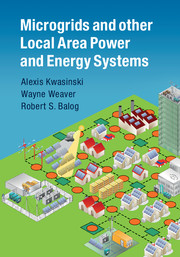9 - LAPES and grid interaction
from Part III - Integration
Published online by Cambridge University Press: 05 July 2016
Summary
This chapter discusses interconnection and interoperation requirements of LAPES with utility power grids. Local area power systems may be designed and operated as either grid-connected or grid-independent systems. This chapter will discuss the requirements for grid interconnectivity from the hardware and control perspective. The issues concerning island detection are also explored, including a review of common island detection techniques. This chapter also presents the main aspects relating to regulatory statues and standards pertaining to the operation of grid-connected and grid-independent systems.
Introduction
From the microgrid definition in Chapter 1, we know that LAPES may or may not be connected to a main grid. Local area power systems may be designed and operated as either grid-connected or grid-independent systems. Examples of both cases were also introduced in Chapter 1, including cases of stand-alone LAPES in remote villages where it is not possible to interact with a main grid, and cases such as the microgrid in Sendai, which is designed to interact with a main grid. Still, grid-connected microgrids must be able to operate disconnected from the grid either by an intentional or unintentional event. When microgrids operate disconnected from a main grid, they are said to be in islanded mode. Islanded operation may be the result of:
– A necessity, as happens with remote villages.
– An involuntary outcome caused by an external action, as happens during natural disasters when grid power outages are common and extensive.
– A desired design, planning, or operational choice, as happens in some LAPES in order to be able to achieve costs and energy savings. In this case, microgrids may be designed with the capability to freely disconnect from the grid – for example, if there is sufficient local power generation – or be connected to it – for example, in order to inject excess local power generation into the grid – or they may be designed as intentional stand-alone microgrids that cannot be connected to a main grid.
Both operational modes – islanded or grid-connected – have implications for the control and stability of the local area power system. Obviously, the operation of a microgrid may also have effects on the main power grid, ranging from planning to operational aspects, which also need to be considered in order to ensure a common adequate operation.
- Type
- Chapter
- Information
- Microgrids and other Local Area Power and Energy Systems , pp. 394 - 430Publisher: Cambridge University PressPrint publication year: 2016



